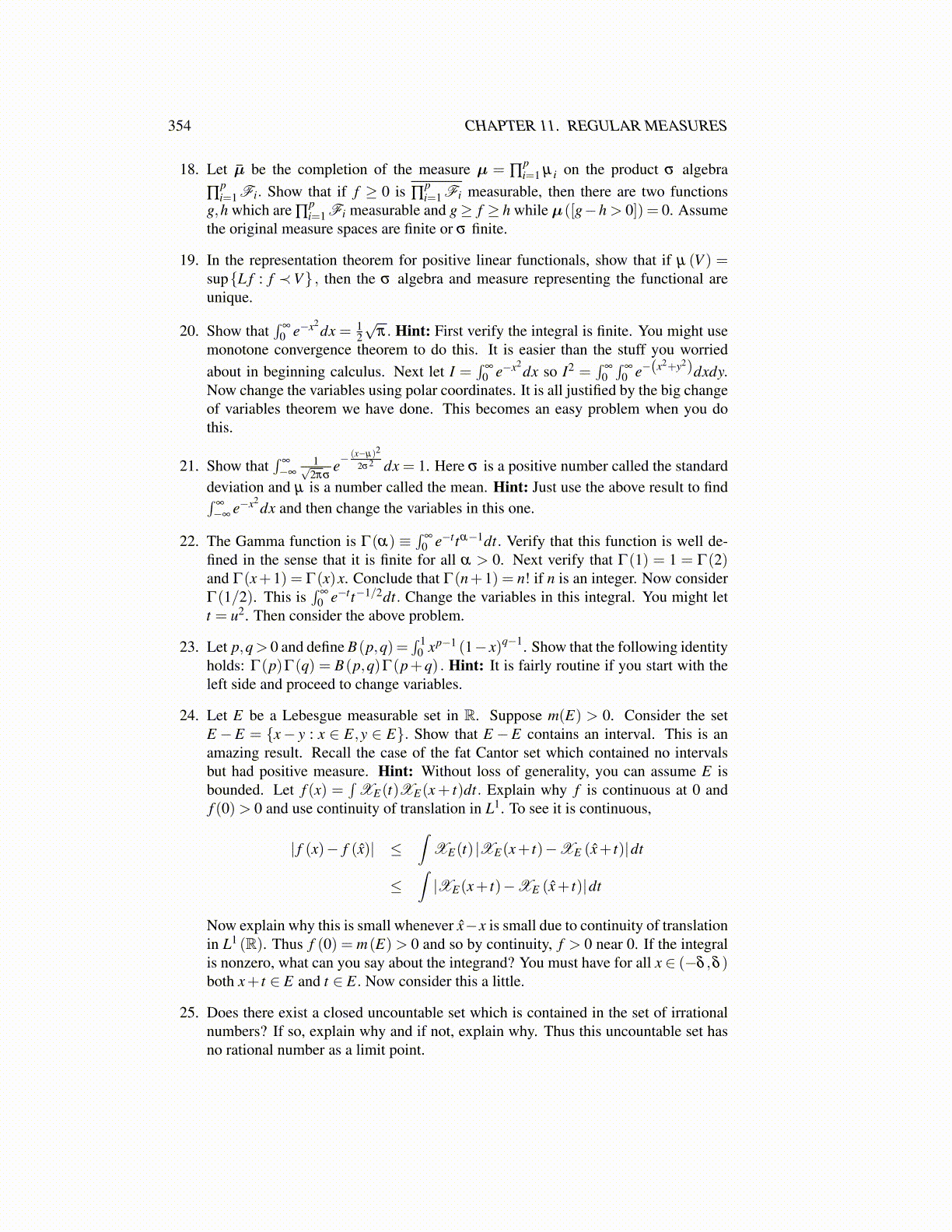
354 CHAPTER 11. REGULAR MEASURES
18. Let µ̄ be the completion of the measure µ = ∏pi=1 µ i on the product σ algebra
∏pi=1 Fi. Show that if f ≥ 0 is ∏
pi=1 Fi measurable, then there are two functions
g,h which are ∏pi=1 Fi measurable and g≥ f ≥ h while µ([g−h > 0]) = 0. Assume
the original measure spaces are finite or σ finite.
19. In the representation theorem for positive linear functionals, show that if µ (V ) =sup{L f : f ≺V} , then the σ algebra and measure representing the functional areunique.
20. Show that∫
∞
0 e−x2dx = 1
2√
π. Hint: First verify the integral is finite. You might usemonotone convergence theorem to do this. It is easier than the stuff you worriedabout in beginning calculus. Next let I =
∫∞
0 e−x2dx so I2 =
∫∞
0∫
∞
0 e−(x2+y2)dxdy.Now change the variables using polar coordinates. It is all justified by the big changeof variables theorem we have done. This becomes an easy problem when you dothis.
21. Show that∫
∞
−∞
1√2πσ
e−(x−µ)2
2σ2 dx = 1. Here σ is a positive number called the standarddeviation and µ is a number called the mean. Hint: Just use the above result to find∫
∞
−∞e−x2
dx and then change the variables in this one.
22. The Gamma function is Γ(α) ≡∫
∞
0 e−ttα−1dt. Verify that this function is well de-fined in the sense that it is finite for all α > 0. Next verify that Γ(1) = 1 = Γ(2)and Γ(x+1) = Γ(x)x. Conclude that Γ(n+1) = n! if n is an integer. Now considerΓ(1/2). This is
∫∞
0 e−tt−1/2dt. Change the variables in this integral. You might lett = u2. Then consider the above problem.
23. Let p,q> 0 and define B(p,q)=∫ 1
0 xp−1 (1− x)q−1. Show that the following identityholds: Γ(p)Γ(q) = B(p,q)Γ(p+q) . Hint: It is fairly routine if you start with theleft side and proceed to change variables.
24. Let E be a Lebesgue measurable set in R. Suppose m(E) > 0. Consider the setE −E = {x− y : x ∈ E,y ∈ E}. Show that E −E contains an interval. This is anamazing result. Recall the case of the fat Cantor set which contained no intervalsbut had positive measure. Hint: Without loss of generality, you can assume E isbounded. Let f (x) =
∫XE(t)XE(x+ t)dt. Explain why f is continuous at 0 and
f (0)> 0 and use continuity of translation in L1. To see it is continuous,
| f (x)− f (x̂)| ≤∫
XE(t) |XE(x+ t)−XE (x̂+ t)|dt
≤∫|XE(x+ t)−XE (x̂+ t)|dt
Now explain why this is small whenever x̂−x is small due to continuity of translationin L1 (R). Thus f (0) = m(E)> 0 and so by continuity, f > 0 near 0. If the integralis nonzero, what can you say about the integrand? You must have for all x ∈ (−δ ,δ )both x+ t ∈ E and t ∈ E. Now consider this a little.
25. Does there exist a closed uncountable set which is contained in the set of irrationalnumbers? If so, explain why and if not, explain why. Thus this uncountable set hasno rational number as a limit point.